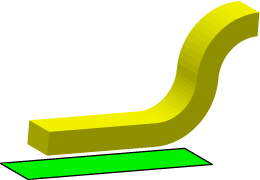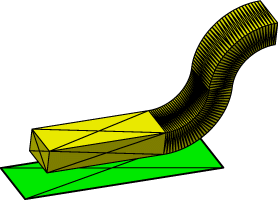Gull Wing home page
Next Gull Wing page
Gull Wing Lead Example gullwing-1 for the
Surface Evolver
 r>
r>
This first file does just the pad and lead geometry, without any solder.
As a result, there is no energy to optimize. The geometry set up
in this file will serve just as display in the later files, so one
can see the pad and lead. This is the time to get various
geometry decisions made before things get too complicated.
Design steps:
- General:
- The first decision is the orientation of the lead.
I choose to center the pad and lead lengthwise along the y axis, so I
see a side view when it loads in the Evolver. On initial loading,
the x axis is out of the screen, and the y axis is to the right.
The horizontal section of the lead is down the negative
y axis (leftwards), and the join to the circular part is at y = 0. "Toe" will
refer to the negative x end of pad and lead, "heel" will refer to
the positive y end (chip end).
- If the geometry were always to stay symmetric about the x = 0 plane,
then we could save about half in storage and execution time by
doing just half the lead and pad. But we will later want to break the
symmetry to calculate the force in the x direction, so we do a full
geometry.
- The geometric dimensions are defined as Evolver parameters. Most of
them could be defined as macros, since they are mostly used as initial
values and changing them at run time would not have the desired effect.
Moving things around will be done by explicitly moving vertices, rather
than just changing parameter values.
The advantage of having them as parameters is that their values are
accessible by name at run time.
- The pad:
- The lead:
- The curved portion of the lead is modeled with circular arcs.
Other curves, such as parabolas or sine waves, could have been used,
but it is simplest to get constant thickness with circular arcs.
- There are six parameters defining the shape of the lead:
parameter thick = 6 //Thickness of lead in the z direction.
parameter width = 10 // Width of lead in y direction
parameter leadtoe = -30 // Toe of lead, relative to heel
parameter bend = 90*pi/180 // bending angle of a curved section, radians
parameter rad = 10 // inside radius of bends
parameter orad = rad+thick // outside radius of bends
Note that the bend angle is expressed as degrees converted to radians,
since Evolver uses radians in trig functions. Leadtoe is
actually the negative length of the horizontal part of the lead.
- The position of the lead is defined by three parameters:
parameter gap = 5 // Height of the bottom of the gull foot above the pad
parameter leadheel = 0 // y coord of flat-curve junction of lead
parameter leadshift = 0 // x offset of centerline of lead
These are the only parameters that should be changed at runtime to move
the lead, and even then the changing should only be done by the
carefully defined movement commands discussed below.
- The curved surfaces of the lead are defined by four level-set
constraints:
constraint 1 // lower side of lower curve
formula: (z-(gap+orad))^2 + (y-leadheel)^2 = orad^2
constraint 2 // upper side of lower curve
formula: (z-(gap+orad))^2 + (y-leadheel)^2 = rad^2
constraint 3 // lower side of upper curve
formula: (z-(gap+(rad+orad)*(1-cos(bend))-rad))^2 +
(y-leadheel-(rad+orad)*sin(bend))^2 = rad^2
constraint 4 // upper side of upper curve
formula: (z-(gap+(rad+orad)*(1-cos(bend))-rad))^2 +
(y-leadheel-(rad+orad)*sin(bend))^2 = orad^2
Constraints 1 and 3 could have been combined into one constraint using
conditional expressions, as could 2 and 4, but there is no real point
in getting that fancy here.
- These constraints will be used only for the display surface.
Constraints with the same formulas will be defined later for the
solder. It is generally wise to keep separate constraints for
display surfaces and energy surfaces.
- No constraints are defined here for the flat surfaces of the lead,
since refining keeps them flat, and the movement commands are guaranteed
to keep them flat.
- I made a hand sketch to number all the vertices, edges, and facets,
and typed them all in. The faces are all oriented with outward normal.
This is not strictly necessary, but I felt like doing it that way.
- I did not make the lead edges and faces
no_refine since
at least the curved surfaces must refine in order to follow the circular
arcs.
- The lead faces are all colored yellow, suggestive of gold, and
distinct from the white that the solder surface will be.
- The
read section: .
- This section of the datafile gets executed after the surface is set
up, just as if the user had typed it in at the command prompt. Two types
of things happen here: commands that execute immediately to initially
massage the surface, and definitions of commands the user can run later.
- The first massaging done is to fix up the triangulation on the
sides of the curved parts of the lead:
// Subdivide some curve edges for better display
refine edge where (id >= 17 and id <= 20) or (id >= 23 and id <= 26)
// Get rid of pesky vertices in middle of curved sides.
delete edge ee where sum(ee.facet,color==yellow)==2 and ee.length < thick/3
foreach facet ff where color==yellow do { fix ff.edge; fix ff.vertex; fix ff}
The problem is that the original
triangulation upon loading can put a vertex too near the inside arc, and
later refining creates facets that cut across the arc. Try commenting out
the refine line and see what refining does. The use of hardwired edge numbers
might be considered poor programming style, but it is the easiest way
to identify these particular edges, and the numbers are not likely to
change in the later datafiles of this series. The delete command
gets rid of a couple of short edges. Since delete won't delete
fixed edges, the side faces were left unfixed in the Faces section.
The last command takes care of that.
-
Next come some commands to move the lead in three directions. For
example, translation in x is done by:
delta_x := 0
move_x := { leadshift := leadshift + delta_x; // do parameters first
set vertex x x+delta_x where z > 0;
}
The movement is relative, of magnitude delta_x. Note that
delta_x is used in an immediately executed assignment statement
so the parser has a declaration of it before its use in move_x
and the user can set delta_x before invoking move_x.
In move_x, the leadshift parameter is changed first,
because setting a vertex coordinate value causes immediate projection
to any constraints it is on, and we want those constraints to be in
the new position.
- Frills:
- To reduce the display to just a wire-frame outline, the file
outline.cmd contains a
command
outline:
outline := { dissolve facet where color==yellow or color==green;
foreach edge ee where original == -1 and valence == 0 do
{ unfix ee; dissolve ee }
}
The dissolve command simply eliminates objects without
collapsing them (as delete does). It will not dissolve
vertices still used by edges, or edges still used by facets. It
will (as of version 2.14) dissolve facets used by bodies. An
original number of -1 is assigned to edges that are
produced by subdividing facets; the condition is used to prevent
dissolving the edges descended from those originally in the datafile.
The unfix is necessary since fixed edges will not be dissolved.
- For later use in totally eliminating all display elements,
outline.cmd also contains the command
vanish:
vanish := { outline;
dissolve edges;
dissolve vertices;
}
- To refine the lead to smoothness with the minimal number of
elements, the file slats.cmd contains
the command
slats. This command refines the curved edges
and faces in such a way as to create a lot of thin, horizontal
triangles, and then fixes the display facets so refining won't
affect them.

- Both of these files are automatically read in at the end of all
the datafiles in this series.
Gull Wing home page
Next gullwing page
Surface Evolver home page
More Surface Evolver examples
Ken Brakke's home page
 r>
r>
